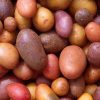Shepherd’s Pie: Winter’s Quintessential Comfort Food

There’s probably no other dish more homey and comforting on a cold winter’s night than a well-made Shepherd’s pie. The origin of this simple and hearty casserole is somewhat obscure, if not downright confusing, with many historians laying its creation to the English. Then there are those who bestow the honor upon the Irish, and even others who say it was the Scots. But on what it seems they all agree: shepherd’s pie came about in the late 1700s as a way for frugal peasant housewives to use their leftover lamb, mutton, and other meats.
The first Shepard’s pies were likely made with pastry crust since the potato, while brought to Europe in the late 16th century, was first looked upon with suspect, charged with everything from leprosy to syphilis, to sterility, and even death. But the potato’s acceptance grew steadily, albeit slowly, and by the early 1800s had become commonplace throughout the continent.
Actually the term Shepherd’s Pie wasn’t coined until the mid-1800s, technically referring to the dish being made with minced lamb or mutton, while a similar dish made with minced beef called Cottage Pie (so named because the peasants who invented it lived in cottages) appeared almost eighty years earlier. Over time however, the distinction between the two was lost and “Shepard’s” pie became synonymous with both, regardless of the protein used in its preparation. This is evidenced by the following recipe from the 5th edition of The Practice of Cookery and Pastry, a book by Mrs. I. Williamson, “teacher of those arts” and “authoress,” printed in Edinburgh, England in 1854.
“Take cold dressed meat of any kind, roast or boiled, slice it, break the bones, and put them on with a little boiling water, and a little salt, boil them until you have extracted al the strength from them, and reduce ti to very little, and strain it. Season the sliced et with pepper and salt lay it in a baking dish, you in the sauce you strained, and add a little mushroom ketchup. Have some potatoes boiled and nicely mashed, cover the dish with the potatoes, smooth it on the top with a knife, notch it round the edge and mark it on the top the same as paste. Bake it in an oven or before the fire, until the potatoes are a nice brown.”
As the British, Irish, and Scott’s migrated to the United States, they brought with them their love for this dish. In fact, so popular was shepherd’s pie with these early colonists that the recipe was included in one of America’s premier cookbooks: the 1886 edition of Mrs. Rorer’s Philadelphia Cook Book (Arnold and Company) written by food writer and America’s first dietitian, Sarah Tyson Rorer.
 Here in the States, shepherd’s pie has, for some unexplainable reason other than perhaps Ireland having some claim on its origin, become synonymous with St. Patrick’s Day. in the Jewish community where, in addition to occasionally being served on Shabbat, it has become a favored Passover meal.
Here in the States, shepherd’s pie has, for some unexplainable reason other than perhaps Ireland having some claim on its origin, become synonymous with St. Patrick’s Day. in the Jewish community where, in addition to occasionally being served on Shabbat, it has become a favored Passover meal.
Variations of this delicious casserole includes the use of leftover Christmas turkey and ham, making it St. Stephen’s Day Pie. Or if you top the potato crust with breadcrumbs and cheese, it becomes Cumberland Pie. There’s a vegetarian version of this popular dish referred to by many simply as Shepherdess Pie or Gardeners Pie. Finally, there’s a modern version that calls for a tater-tots topping instead of mashed potatoes, known merely as Tater Tot Casserole
Other cultures have their versions of mashed potato topped casseroles, too. The British mariners have fish pie, made with various kinds of seafood in place of meat. The French-Canadian version, pâté chinois, has a filling made with ground beef and canned corn. Spanish-speaking South American countries call theirs pastel de papa; prepared with layers of chopped hard-boiled eggs, back olives, and raisins. The Indonesians make their version with chicken, called pastel tutup, to name just a few.
So now that you know a little of the history behind Shepherd’s pie, we hope you’ll give our recipe a try. And whether you use beef, lamb, or chicken, top it with mashed potatoes, pastry crust, or tater tots, load your filling with plenty of root vegetables, celery, and peas for a delicious, satisfying one-pot cold weather meal . . . or anytime for that matter.




